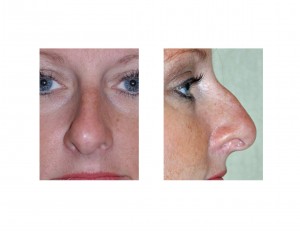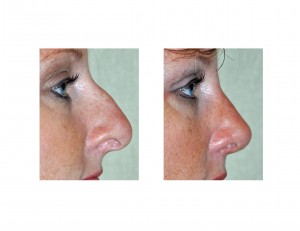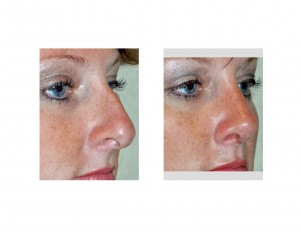Background:Rhinoplasty is known to reshape a wide variety of nose appearances. While everyone’s nose is truly different, there are some classic nasal shapes that many people of vastly different ethnicities share. The appearance of such nose shapes can cast certain impressions about the owner that varies amongst different cultures. One of the most common and recognizeable nose ‘deformities’ is that of the hook or bent nose.
Certain noses have a hooked shape that resembles the beak of a parrot. This gives a very recognizeable shape in profile, that when cartooned to excess, is used in characters such as that of a witch with a long and downturned nose. Ideally, the angle between the upper lip and the nose (the nasolabial angle) should be between 90-105 degrees in women and between 90-95 degrees in men. When this angle is smaller than 90 degrees, it gives the appearance that the tip of the nose is drooping and it can also make the individual seem older than their age.
The hooked or beaked nose is also known as the Aquiline or Roman nose. This is a commonly perceived to be a nose that has a prominent bridge giving it the appearance of being curved or slightly bent. The word aquiline is of Latin origin deriving from the word aquilinus (‘eagle-like’) with an obvious reference to the curved beak of an eagle.



Correction of the hooked nose by rhinoplasty requires multiple maneuvers to make a smooth nasal dorsum and a dorso-columellar and nasolabial angles that are closer to 90 degrees. Much of the surgical manipulations come from reducing and reshaping the large overgrown nasal septum. The nasal bones and the tip cartilages are then reshaping and attached to it. Opening of the airway by septal straightening, open of the internal nasal valve andreducing the size of the turbinates are important steps to improve almost always compromised nasal breathing.
Case Highlights:
1) The hooked or aquiline nose can be dramatically improved through rhinoplasty. It can be one of the most dramatic ‘nose makeovers’.
2) The hooked nose is treated by an open rhinoplasty based on reducing the height of the bridge and shortening and lifting the tip of the nose.
3) The hooked nose deformity often has associated breathing problems that can be treated at the same time as the external changes.
Dr. Barry Eppley
http://www.eppleyplasticsurgery.com
Indianapolis, Indiana


